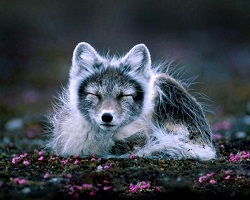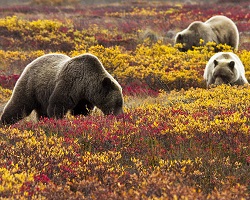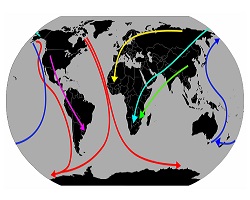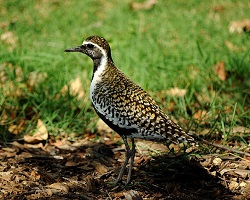How Do Animals Survive In The Tundra
Animals of the Tundra

Animals of the tundra, similar this caribou, are well adapted to the cold and dry atmospheric condition. Click for more than detail.
Could yous handle always living in the common cold? Some animals tin can. Animals of all sizes have adjusted to harsh atmospheric condition atmospheric condition and long winters of the tundra.
Many animals have shorter legs and ears to minimize exposing their skin to the cold. Some are also well adapted to living loftier upward in the mountains. For example, mammals at high elevation are able to utilise oxygen more than efficiently.
Small creatures, such every bit ground squirrels, tin can seek refuge in vegetation but because it's usually sparse and low, it may expose them to predators. To avoid danger, some species have evolved to exist fast runners or to be inconspicuous.

The mixed fur colors of this arctic fox show the white wintertime coat giving way to the night summer coat. Click for more than particular.
Between summer and winter, the grayish-brown fur of snowshoe hare, arctic play a joke on, and others similar them blends into white hairs in preparation for winter camouflage.
Sometimes prey animals feed at night to avoid beingness eaten. They may also reproduce a lot since not all immature will survive to adulthood.
Fatty = Energy?
Another central to an animal's survival in the tundra is knowing when to swallow and when to slumber in lodge to save free energy. Many animals in the tundra hibernate during the long, common cold winter months.

Grizzly bears make sure to become enough nutrient during the warm seasons on the tundra so they can hibernate through the colder winter months. Prototype past Albert Herring.
Hibernation is a period of rest lasting several months. During this time, animals stay hidden in dens. Their metabolisms lower into a dormant state, so less energy is required for their bodies to perform the necessary functions. For that energy, they rely on stores of fat they congenital upward over the summer.
Tundra animals have other strategies to keep warm too. It helps to have a lot of fur and fatty. Subsequently all, the colder information technology is, the more than energy it takes for a mammal to maintain a stable body temperature to live.
But like in other biomes, in the tundra, unlike types of animals go energy from different types of foods. Carnivores are at the top of the food web because they are meat eaters.

This crabeater seal lives on the coast of Antarctica. It tin can store fatty easily, edifice a thick blubber to protect it from the cold. Image by François Guerraz.
Carnivorous mammals such as wolves and seals prey on smaller animals to survive while herbivorous mammals only consume plant-based foods. Animals that consume both other animals and plants are called omnivores.
Lemmings, voles, caribou, chill hares and squirrels are examples of tundra herbivores at the bottom of the food web. They often accept a strong sense of odor to aid them notice nutrient underneath the snow.
Timing is Everything
Summertime melts away the snow, allowing shallow wetlands to form. In the bachelor pools of water, insects breed and concenter birds. This explains why animals are about active in the short summer. They forage heavily on the plentiful insects and flowers that are in bloom before they are forced to hibernate or drift to a warmer place for wintertime. Luckily, during the long-lighted days of summertime, in that location is more time in each twenty-four hours to hunt for nutrient.

This map shows migration routes taken by several birds, including some that live in the tundra. Click for more detail.
Summer is for mating, too. Everything from insects, similar mosquitoes, flies, moths, grasshoppers, blackflies and arctic bumble bees, to larger animals take advantage. It turns into a race against time.
Migratory birds such as falcons, loons, sandpipers, terns and snow birds must successfully produce young during the brusk summer. If they don't, there is not enough time to start over with a second nest.
Even given constraints like these, a lot of animals call the tundra habitation for at least part of the year. As the seasons modify, and then practise the species constitute in the tundra.

Pacific golden plover spend part of the yr in the Alaskan tundra, and role in South America. Prototype by Daniel Ramirez.
Young plover, a kind of bird, are abandoned on the tundra in Alaska and have to brand their manner back to Argentine republic in South America on their own. The adult parents leave earlier, perchance to allow more nutrient for the immature.
Stories like the plovers' are normal for species that spend function of the time in the tundra.
Insect Anti-Freeze
Picture holding an insect in your hand and how tiny it looks compared to you lot and everything else. Fifty-fifty small insects live in the tundra. But how practice they survive in below-freezing temperatures? For some, the answer is antifreeze.
If you've heard of antifreeze, it was probably from someone with a car. In cars, antifreeze is a manmade (and very dangerous) chemical mixture that allows all the water-based liquids to operate in a wide range of low and high temperatures.

All the tiny dots in this picture show are mosquitoes. Merely how do mosquitoes live in the cold atmospheric condition of the tundra? Click for more detail.
Just like it's important for a car to function, antifreeze in tundra insects is critical for life. Insect antifreeze is a naturally occurring protein that lowers the freezing point of water in insect bodies.
The protein'southward structure as well lets information technology attach to ice crystals to prevent more from forming. Not only practice insects benefit from this adaptation, merely arctic fish do as well.
The common cold can affect insects in other ways, as some insects mature very slowly, maybe taking x to xv years to pass through all their larval stages. This dull growth occurs because they tin only get a little food each short summer. No affair the size of the beast, life in the tundra can exist tough.
Images via Wikimedia commons. Woolly bear image via IronChris.
Source: https://askabiologist.asu.edu/animals-tundra
Posted by: tathamferamplon.blogspot.com

0 Response to "How Do Animals Survive In The Tundra"
Post a Comment